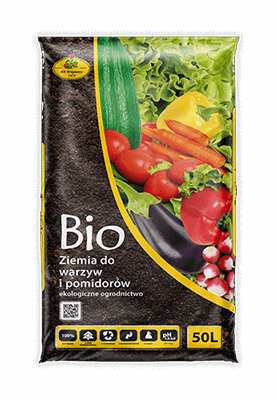



• Organic gardening
• Growing vegetables including tomatoes, cucumbers, peppers, zucchini, eggplant, lettuce, carrots, radishes, beans, herbs, fruits, e.g. strawberries, wild strawberries etc.
• Growing in the gardens, on balconies, terraces, in greenhouses
• Growing in pots: vegetables, herbs, fruit plants
• Enrichment of poor soils with humus, nutrients and structure improvement
• An ideal product to promote environmental issues, supporting crops in harmony and harmony with nature
• Compost and composted bark provides biological activity and soil fertility
• Vermicompost and guano provides a high but balanced amount of nutrients and microorganisms for plants
• A carefully selected recipe ensures proper storage and supply of water to plants
• Salinity: <2,5g/l
• Structure: 0-40mm
• Only ingredients approved for organic gardening according to Regulation EC 834/2007
• The best planting time is spring
• The product is mechanically pressed, before use it is recommended to loosen it and, if necessary, when the substrate is dry, soak it with water
Greengrocer
• Spread BIO substrate for vegetables and tomatoes to a depth of about 15 - 30 cm, forming beds if necessary
• Then sow or plant plants
Growing in pots
• Vegetables, herbs and fruits can be grown in pots and boxes on sunny and sheltered balconies, terraces
• Choose a clean pot with drain holes
• Pour drainage to the bottom of the pot, e.g. expanded clay, then BIO substrate for vegetables and tomatoes
• Insert the plant and fill with soil up to 2 cm below the edge of the flower pot
• After transplanting, lightly knead the soil and water moderately
Soil enrichment
• BIO substrate for vegetables and tomatoes should be spread on soil (about one sack 50L per 1m²) and excavated
Advices
• Fertilization should start 4 - 6 weeks after planting, preferably using ecological fertilizers
• We recommend watering with rainwater, which contains less calcium compounds and has a low effect on changing the acidity of the soil
Fertilization
• Tomatoes. Tomatoes have high nutritional requirements. In spring, before planting, it is worth enriching the soil with manure in a dose of 2-3 kg / 1m³. The greatest demand for nutrients occurs in July and August. Tomatoes can be fertilized with one-component fertilizers, e.g. ammonium nitrate or multi-component fertilizers, e.g. Florovit or Azofoska. The first fertilization is carried out 15 days after planting, and the next one every 15 days. A month before the expected end of tomato cultivation, we do not fertilize them. If we decide to use natural fertilization, it is worth using bird manure diluted in water for this purpose. Water the tomatoes with it every 4 days.
• Cucumbers. In the case of cucumbers, ensure an adequate nitrogen dose at the beginning of growth. Cucumbers produce a lot of green mass. Only during the yielding period, pay attention to the potassium and phosphorus content. A natural source of nitrogen can be compost in the amount of 3 kg / 1m³. Chemical fertilization should be carried out with multi-component fertilizers that have the appropriate amounts of phosphorus and potassium, e.g. Substral or Target. We fertilize the plants every 2 weeks from April to September. If we decide to use natural fertilization, it is worth choosing granulated manure for this purpose.
• Lettuce. Lettuce is one of the vegetables with low nutritional requirements. In the case of mineral fertilizers, we pay attention to phosphorus-potassium fertilization. Excess nitrogen is unfavorable for her. Lettuce is sensitive to chlorides, so we make sure that fertilizers do not contain it. Lettuce responds perfectly to natural fertilizers. We recommend any fertilizers of this type, such as manure, compost or vermicompost.